Investigation of Unsteady Flow Interactions in a Transonic High Pressure Turbine Using Nonlinear Harmonic Method
Abstract
:1. Introduction
2. Nonlinear Harmonic Method
3. Test Case
4. Numerical Method
5. Numerical Grid
6. Boundary Conditions
7. Validation of Numerical Method
8. Results and Discussions
8.1. Overall Comparison of Numerical Schemes
8.2. Stator Flow Field
8.3. Rotor Flow Field
8.4. Stator-Rotor Interaction
8.5. Deterministic Stress/Enthalpy Study
9. Conclusions
- (1)
- The stator wakes are chopped as they enter the rotor passage by the rotor leading edge. The chopped wake segments travel through the rotor passage independently. They also interfere with the rotor trailing edge shocks, creating a source of unsteadiness for the trailing edge flow. The R/S interface treatment in the NLH method has shown good capability for reproducing the unsteady signals across the interface. Some minor differences can be seen across the R/S interface, which can be further satisfied by increasing the numbers of harmonics.
- (2)
- Static pressure distribution has been used to explain the triggering mechanism and the phase-locking of the wake shedding phenomena. The pressure wave generated by the reflection of the stator trailing edge shock on the suction side of the passing rotor blade is responsible for the phase locking. These pressure waves travel upstream and enforce the wake shedding as they strike the rear section of the stator suction side, where it interacts with the boundary layer. These pressure waves are strong enough to travel downstream within the rotor passage and influence the rotor trailing edge flow. The impingement of the stator shock and the accumulation of chopped stator wakes on the rotor suction side have induced higher periodic fluctuations on the suction side compared with the pressure side.
- (3)
- The distribution of the deterministic correlations shows that the flow unsteadiness is particularly stronger in the Y and Z directions. Furthermore, the distributions of the deterministic correlations indicate that, some empirical deterministic correlations models based on the decay concept of compressors are not suitable for turbines.
Acknowledgments
Author Contributions
Conflicts of Interest
Nomenclature
| N | number of harmonics of perturbations |
| conservative flow variable | |
| position vector | |
| time | |
| imaginary unit | |
| angular frequency | |
| grid resolution in circumferential direction | |
| number of rotor blades | |
| number of stator blades | |
| V | velocity |
| density | |
| DCS | deterministic stress |
| DCH | deterministic enthalpy |
| Subscripts | |
| periodic fluctuation index | |
| Superscripts | |
| ˉ | time mean |
| ′ | periodic perturbation |
| ~ | harmonic complex amplitude |
References and Note
- Blumenthal, R.; Hutchinson, B.; Zori, L. Investigation of transient CFD methods applied to a transonic compressor stage. In Proceedings of the ASME 2011 Turbo Expo Turbine Technical Conference and Exposition, Vancouver, BC, Canada, 6–10 June 2011. [Google Scholar] [CrossRef]
- Emunds, R.; Jennions, I.K.; Bohn, D.; Gier, J. The computation of adjacent blade-row effects in a 1.5 stage axial flow turbine. In Proceedings of the ASME 1997 International Gas Turbine and Aeroengine Congress and Exhibition, Orlando, FL, USA, 2–5 June 1997. [Google Scholar] [CrossRef]
- Gerolymos, G.A.; Hanisch, C. Multistage three-dimensional Navier-Stokes computation of off-design operation of a four-stage turbine. Proc. Inst. Mech. Eng. Part A 1999, 213, 243–261. [Google Scholar] [CrossRef]
- Ashworth, D.A.; Ashworth, J.E.; Schultz, D.L.; Grindrod, K.J. Unsteady aerodynamic and heat transfer processes in a transonic turbine stage. J. Eng. Gas Turbines Power 1985, 107, 1022–1030. [Google Scholar] [CrossRef]
- Liu, Y. Aerodynamics and heat transfer predictions in a highly loaded turbine blade. Int. J. Heat Fluid Flow 2007, 28, 932–937. [Google Scholar] [CrossRef]
- Giles, M.B. Stator/rotor interaction in a transonic turbine. J. Propuls. Power 1990, 6, 621–627. [Google Scholar] [CrossRef]
- Stieger, R.; Hodson, H. The unsteady development of a turbulent wake through a downstream low-pressure turbine blade passage. J. Turbomach. 2005, 127, 388–394. [Google Scholar] [CrossRef]
- Cui, J.; Rao, V.N.; Tucker, P. Numerical investigation of contrasting flow physics in different zones of a high-lift low-pressure turbine blade. J. Turbomach. 2016, 138, 011003. [Google Scholar] [CrossRef]
- Binder, A.; Schroeder, T.; Hourmouziadis, J. Turbulence measurements in a multistage low-pressure turbine. ASME J. Turbomach. 1989, 111, 153–161. [Google Scholar] [CrossRef]
- Zhao, W.; Luo, W.; Zhao, Q.; Xu, J. Investigation on the reduction of trailing edge shock losses for a highly loaded transonic turbine. In Proceedings of the ASME Turbo Expo 2016: Turbomachinery Technical Conference and Exposition, Seoul, South Korea, 13–17 June 2016. [Google Scholar] [CrossRef]
- Urbikain, G.; Alvarez, A.; López de Lacalle, L.N.; Arsuaga, M.; Alonso, M.A.; Veiga, F. A reliable turning process by the early use of a deep simulation model at several manufacturing stages. Machines 2017, 5, 15. [Google Scholar] [CrossRef]
- Artetxe, E.; Olvera, D.; de Lacalle, L.N.L.; Campa, F.J.; Olvera, D.; Lamikiz, A. Solid subtraction model for the surface topography prediction in flank milling of thin-walled integral blade rotors (IBRs). Int. J. Adv. Manuf. Technol. 2017, 90, 741–752. [Google Scholar] [CrossRef]
- Wang, H.; Zhang, H.; Zhao, Q.; Yang, K.; Zhang, Z.; Zhao, X.; Xu, J. Unsteady numerical simulation of shock systems in vaneless counter-rotating turbine. J. Eng. Thermophys. 2007, 28, 477–485. [Google Scholar]
- Göttlich, E.; Woisetschläger, J.; Pieringer, P.; Hampel, B.; Heitmeir, F. Investigation of vortex shedding and wake-wake interaction in a transonic turbine stage using laser-doppler-velocimetry and particle-image-velocimetry. J. Turbomach. 2006, 128, 178–187. [Google Scholar] [CrossRef]
- Woisetschläger, P.P.-E.G.-J.; Heitmeir, W.S.-F. Numerical investigation of the unsteady flow through a transonic turbine stage using an innovative flow solver. In Proceedings of the 6th European Conference on Turbomachinery, At Lille, France, 7–11 March 2005. [Google Scholar]
- Lin, D.; Yuan, X.; Su, X. Local entropy generation in compressible flow through a high pressure turbine with delayed detached eddy simulation. Entropy 2017, 19, 29. [Google Scholar] [CrossRef]
- Cui, J.; Rao, V.N.; Tucker, P.G. Numerical investigation of secondary flows in a high-lift low pressure turbine. Int. J. Heat Fluid Flow 2017, 63, 149–157. [Google Scholar] [CrossRef]
- Vilmin, S.; Lorrain, E.; Tartinville, B.; Capron, A.; Hirsch, C. The nonlinear harmonic method: From single stage to multi-row effects. Int. J. Comput. Fluid Dyn. 2013, 27, 88–99. [Google Scholar] [CrossRef]
- NUMECA International User Manual FINE™/Turbo V10.2. 2016.
- Vilmin, S.; Lorrain, E.; Debrabandere, F.; Tartinville, B.; Capron, A.; Hirsch, C. The nonlinear harmonic method applied to the combined effects of multi-row unsteady flows. In Proceedings of the ASME Turbo Expo 2013: Turbine Technical Conference and Exposition, San Antonio, TX, USA, 3–7 June 2013. [Google Scholar] [CrossRef]
- Liu, B.J.; Zhang, B.; Liu, Y.W. Numerical investigations of impeller–diffuser interactions in a transonic centrifugal compressor stage using nonlinear harmonic method. Proc. Inst. Mech. Eng. Part A 2014, 228, 862–877. [Google Scholar] [CrossRef]
- Lei, W.; Bo, L. Investigation of the unsteady flow in a counter-rotating compressor using the nonlinear harmonic method. Int. J. Energy Sci. 2012, 2, 182–188. [Google Scholar]
- Lestriez, R.; Amet, E.; Tartinville, B.; Hirsch, C. Non-linear harmonic flow simulations of a high-head francis turbine test case. In IOP Conference Series: Earth and Environmental Science; IOP Publishing: Bristol, UK, 2016; p. 62011. [Google Scholar]
- Liu, B.J.; Zhang, B.; Liu, Y.W. Investigation of model development for deterministic correlations associated with impeller-diffuser interactions in centrifugal compressors. Sci. China Technol. Sci. 2015, 58, 499–509. [Google Scholar] [CrossRef]
- Liu, Y.W.; Liu, B.J.; Lu, L.P. Study of modeling unsteady blade row interaction in a transonic compressor stage part 1: Code development and deterministic correlation analysis. Acta Mech. Sin. 2012, 28, 281–290. [Google Scholar] [CrossRef]
- Wang, L.; Liu, B.; Yang, X.; Cao, Z. Unsteady simulation of a counter–rotating research compressor using the nonlinear harmonic method. Proc. Inst. Mech. Eng. Part G 2013, 227, 415–424. [Google Scholar] [CrossRef]
- Zhang, P.; Liu, B.; Shi, L.; Li, J. Investigation of the unsteady flow of a transonic compressor using the nonlinear harmonic method. Proc. Inst. Mech. Eng. Part G 2016, 230, 1263–1272. [Google Scholar] [CrossRef]
- Jameson, A. Application of Dual Time Stepping to Fully Implicit Runge Kutta Schemes for Unsteady Flow Calculations. In Proceedings of the 22nd AIAA Computational Fluid Dynamics Conference, Dallas, TX, USA, 22–26 June 2015; p. 2753. [Google Scholar]
- Bradshaw, P. Turbulence modeling with application to turbomachinery. Prog. Aerosp. Sci. 1996, 32, 575–624. [Google Scholar] [CrossRef]
- Zeschky, J.; Gallus, H. Effects of stator wakes and spanwise nonuniform inlet conditions on the rotor flow of an axial turbine stage. In Proceedings of the ASME 1991 International Gas, Turbine and Aeroengine Congress and Exposition, Orlando, FL, USA, 3–6 June 1991. [Google Scholar] [CrossRef]
- Walraevens, R.; Gallus, H. Testcase 6–1-1/2 Stage Axial Flow Turbine. Ercoftac Testcase 1997, 6, 201–212. [Google Scholar]
- Reinmöller, U.; Stephan, B.; Schmidt, S.; Niehuis, R. Clocking effects in a 1.5 stage axial turbine: Steady and unsteady experimental investigations supported by numerical simulations. In Proceedings of the ASME Turbo Expo 2001: Power for Land, Sea, and Air, New Orleans, LA, USA, 4–7 June 2001. [Google Scholar] [CrossRef]
- Liu, Y.W.; Liu, B.J.; Lu, L.P. Investigation of unsteady impeller-diffuser interaction in a transonic centrifugal compressor stage. In Proceedings of the ASME Turbo Expo 2010: Power for Land, Sea, and Air, Glasgow, UK, 14–18 June 2010. [Google Scholar] [CrossRef]
- Adamczyk, J.J. Model equations for simulating flows in multistage turbomachinery. In Proceedings of the ASME 1985 International Gas Turbine Conference and Exhibit, Houston, TX, USA, 18–21 March 1985. ASME Paper No. 85-GT-226. [Google Scholar]
- Adamczyk, J.J.; Mulac, R.A.; Celestina, M.L. A Model for closing the invisid form of the average passage equation system. J. Turbomach. 1986, 108, 180–186. [Google Scholar] [CrossRef]
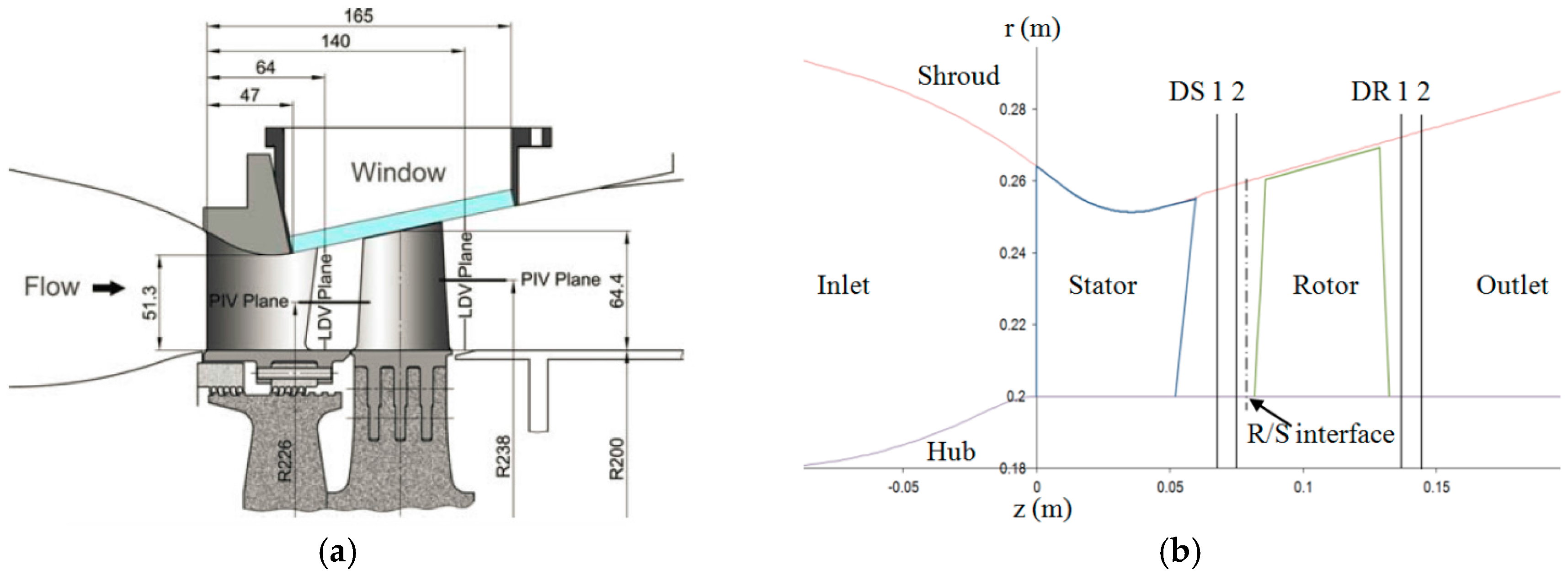

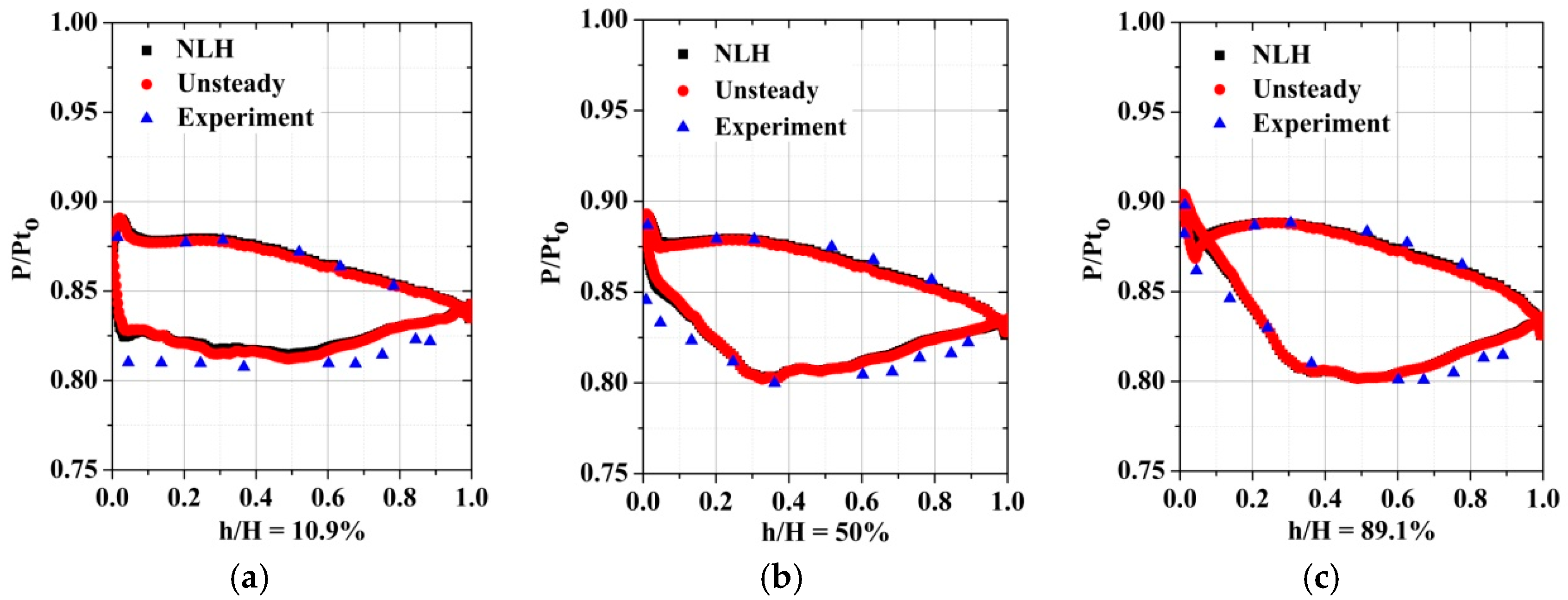
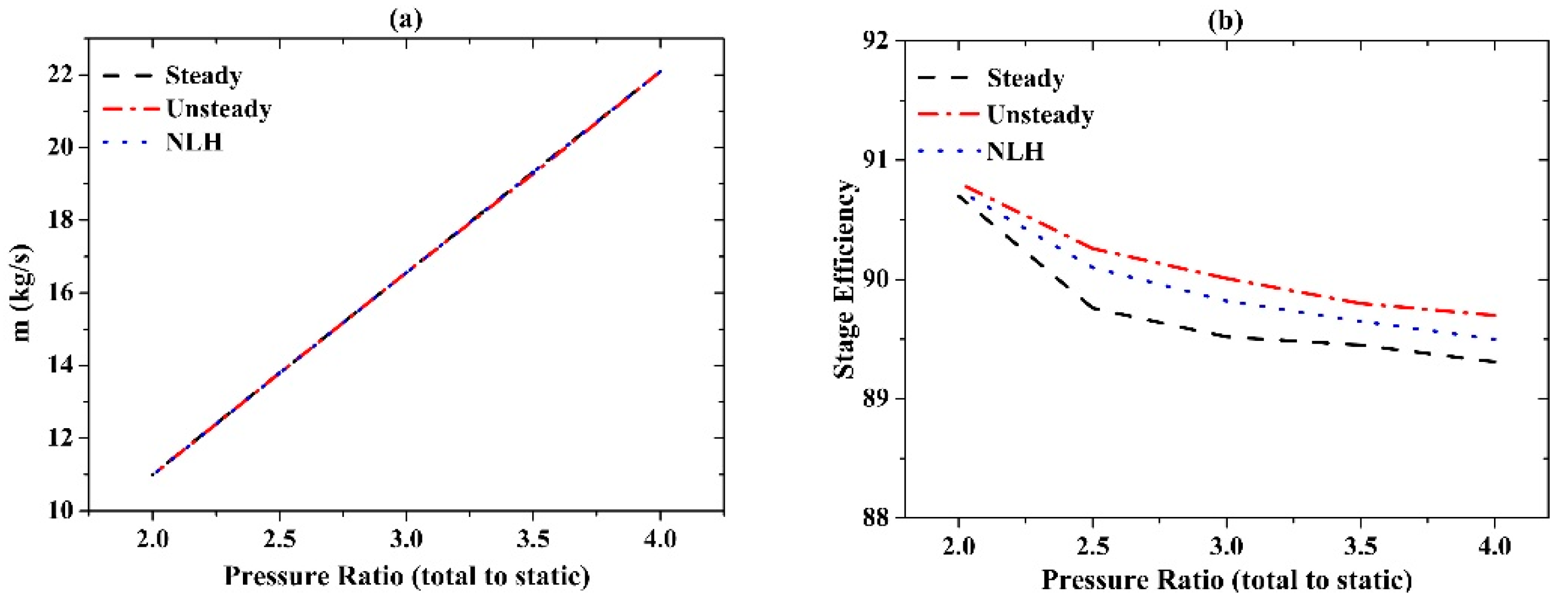
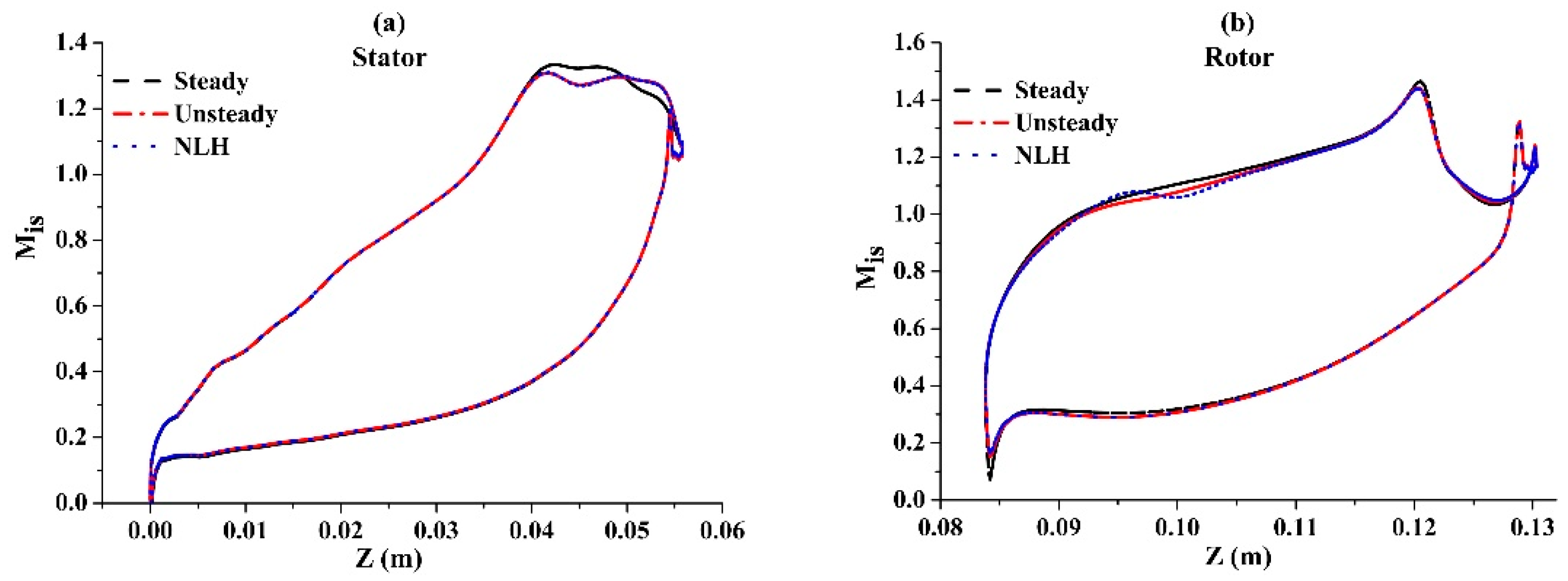


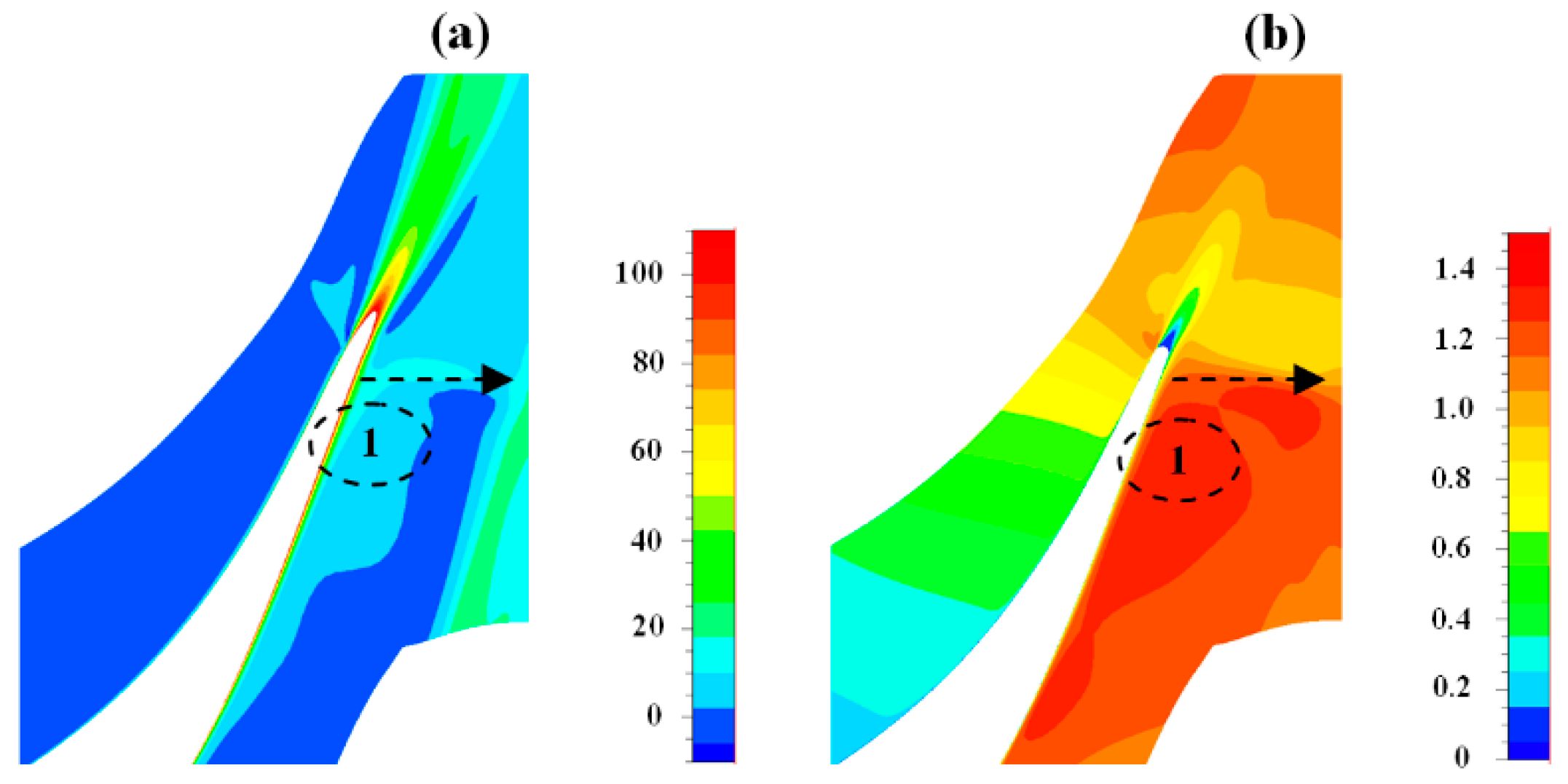


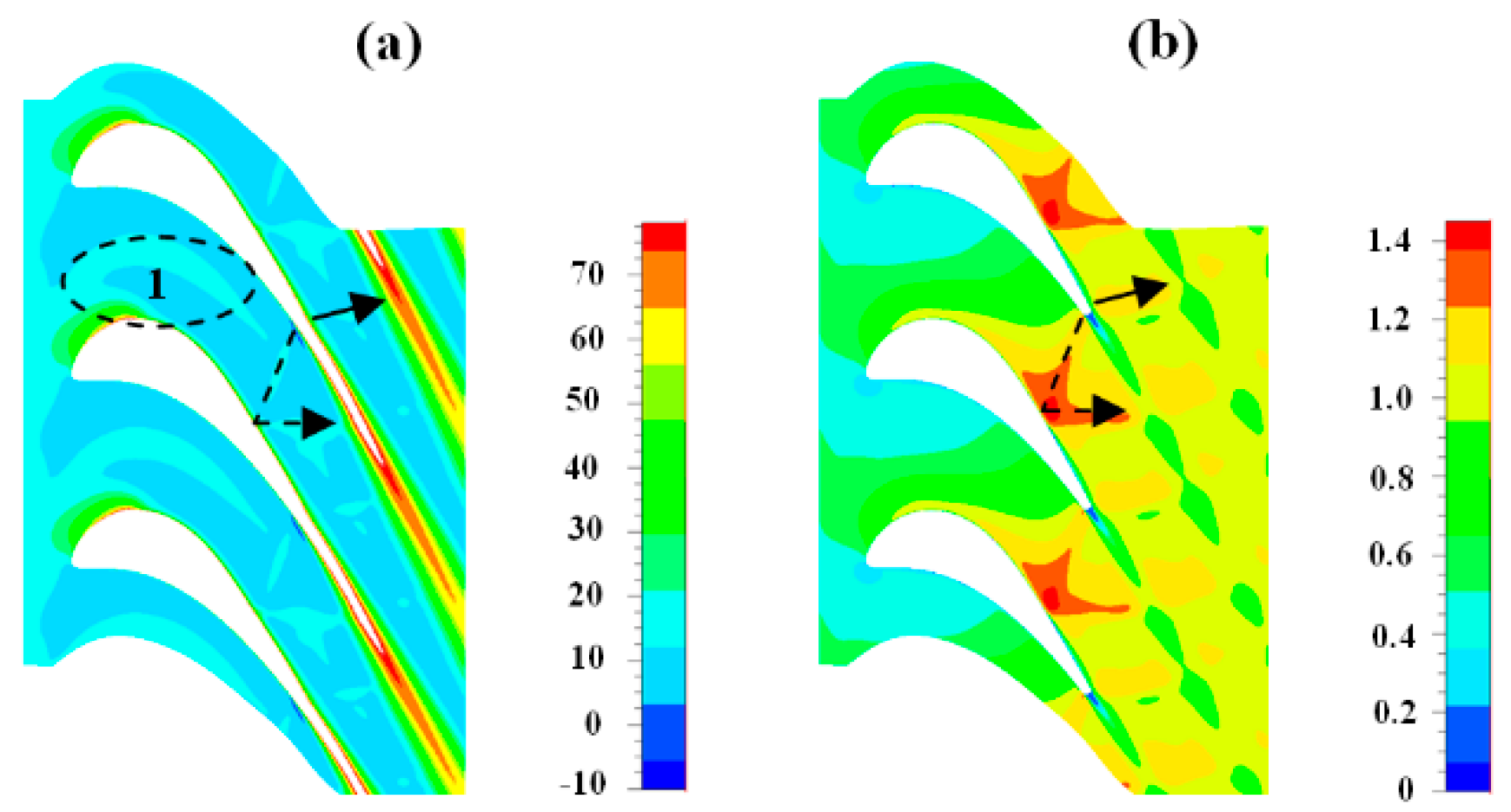

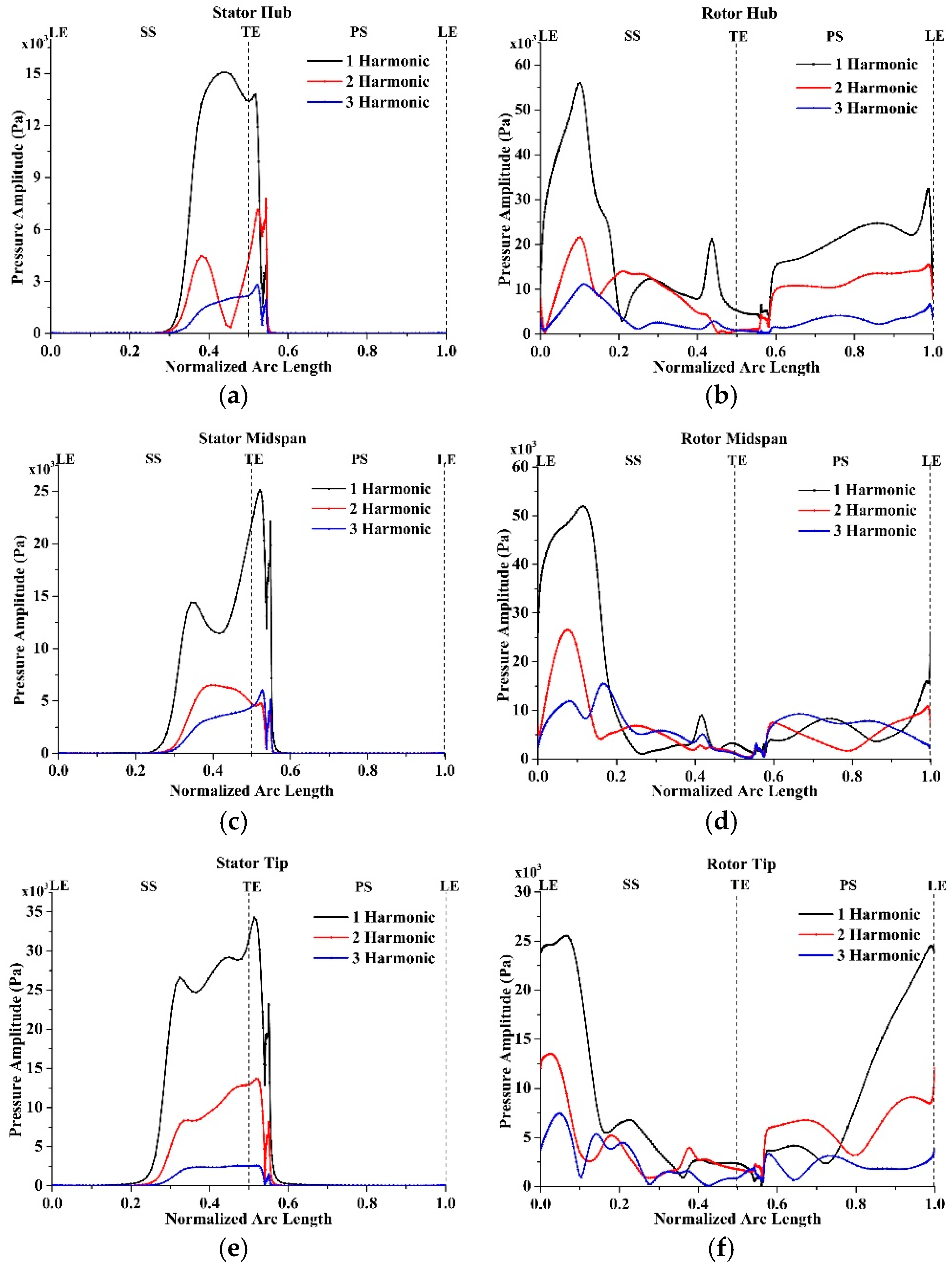
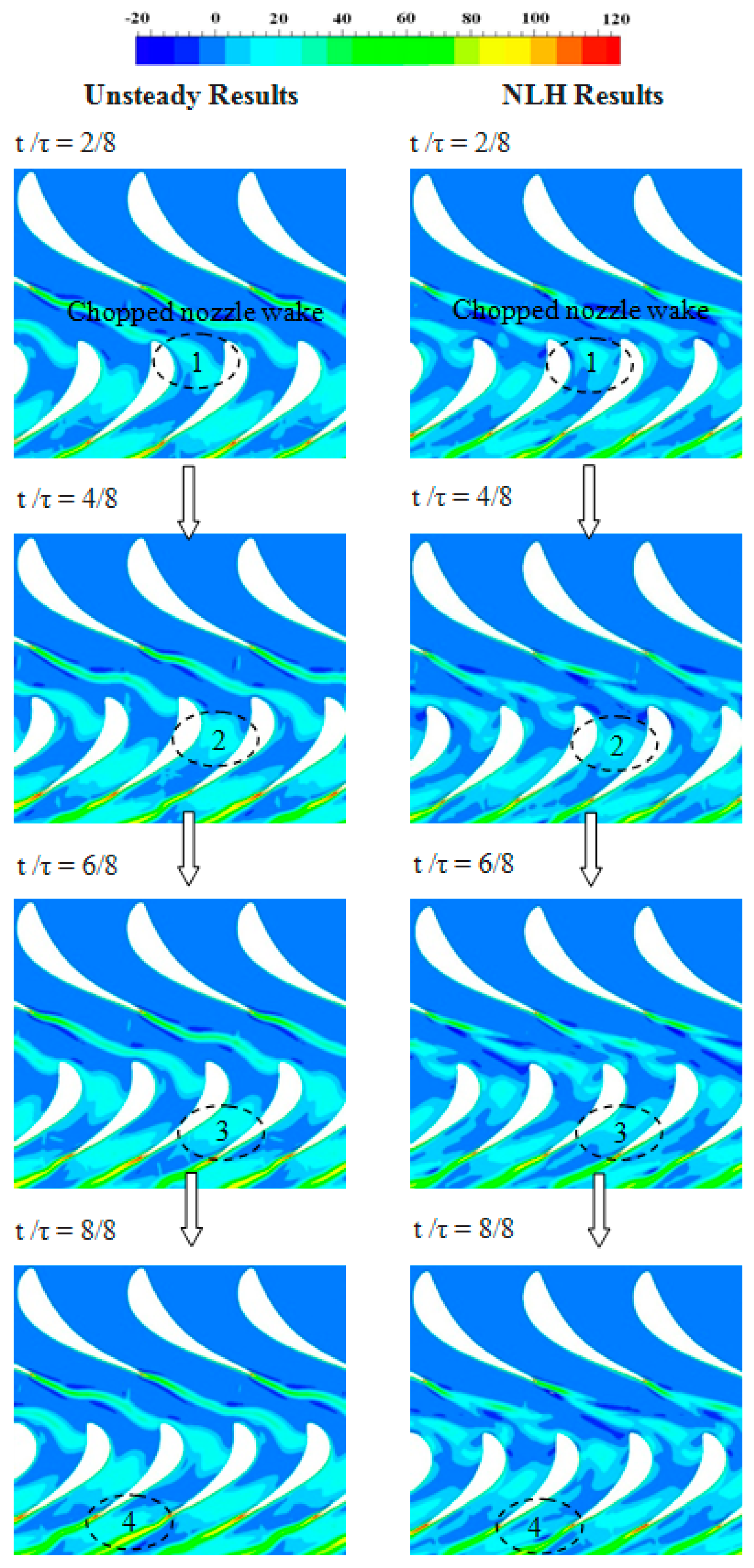
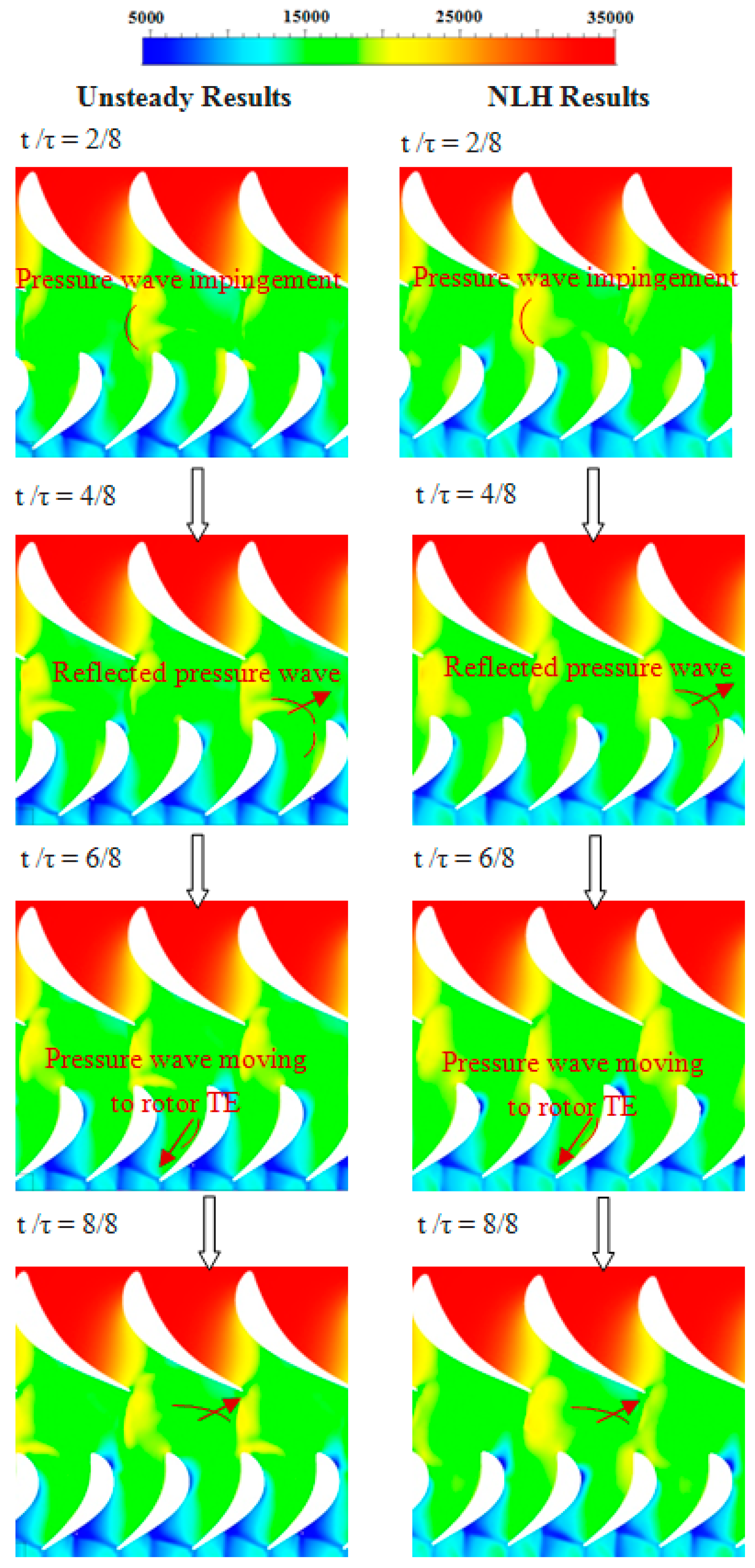
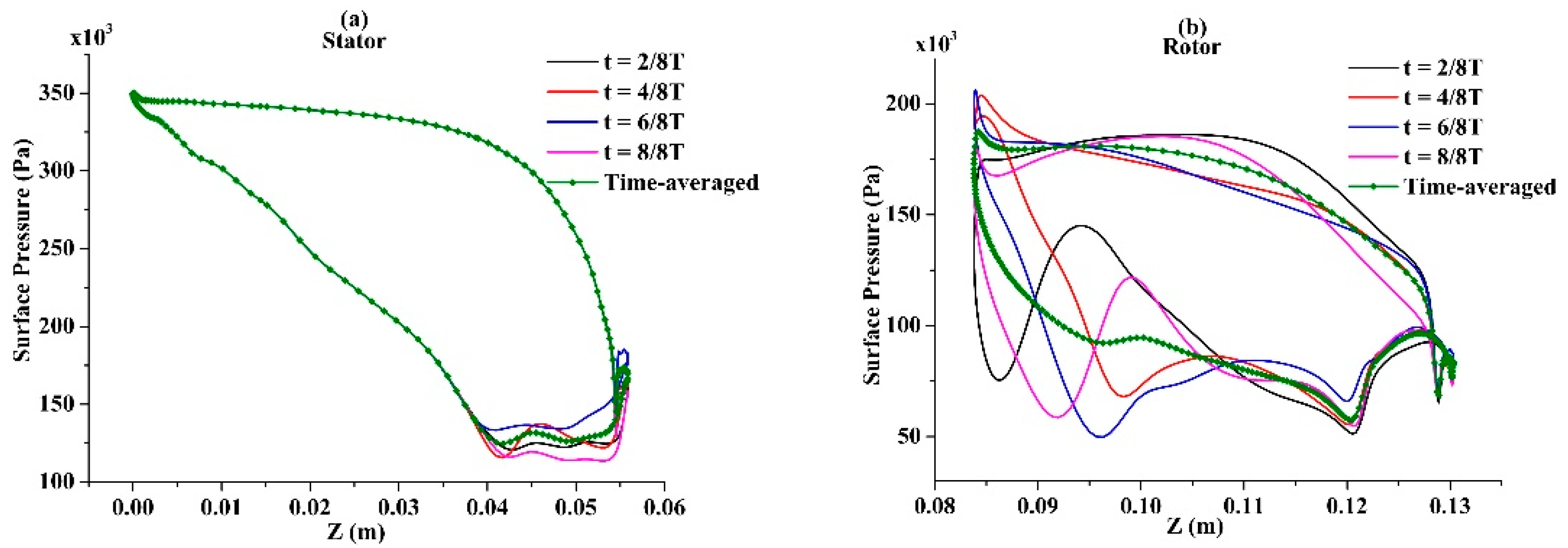



© 2018 by the authors. Licensee MDPI, Basel, Switzerland. This article is an open access article distributed under the terms and conditions of the Creative Commons Attribution (CC BY) license (http://creativecommons.org/licenses/by/4.0/).
Share and Cite
Asghar, M.A.; Liu, Y.; Cui, J.; Lu, L. Investigation of Unsteady Flow Interactions in a Transonic High Pressure Turbine Using Nonlinear Harmonic Method. Energies 2018, 11, 342. https://doi.org/10.3390/en11020342
Asghar MA, Liu Y, Cui J, Lu L. Investigation of Unsteady Flow Interactions in a Transonic High Pressure Turbine Using Nonlinear Harmonic Method. Energies. 2018; 11(2):342. https://doi.org/10.3390/en11020342
Chicago/Turabian StyleAsghar, Muhammad Afzaal, Yangwei Liu, Jiahuan Cui, and Lipeng Lu. 2018. "Investigation of Unsteady Flow Interactions in a Transonic High Pressure Turbine Using Nonlinear Harmonic Method" Energies 11, no. 2: 342. https://doi.org/10.3390/en11020342




